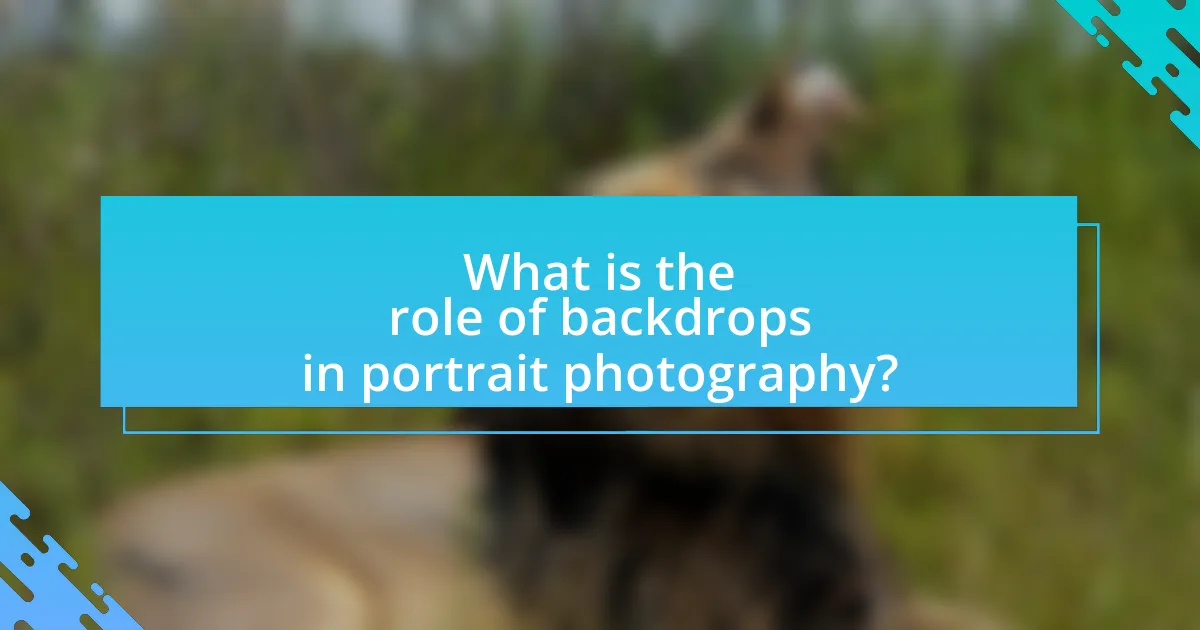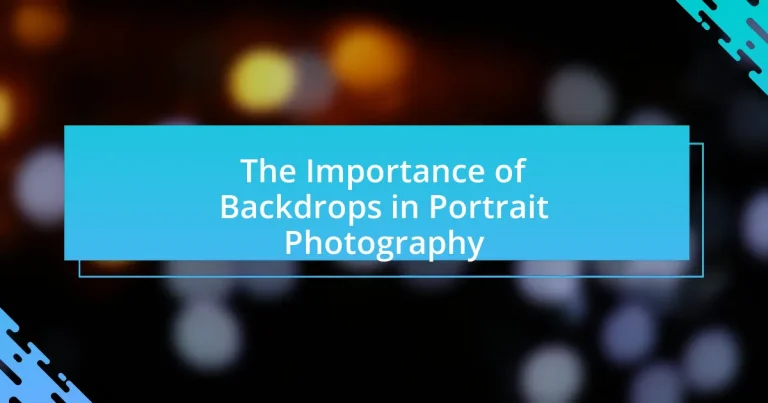The article focuses on the critical role of backdrops in portrait photography, emphasizing their ability to enhance the subject by providing context, depth, and visual interest. It explores how backdrops influence overall composition, mood, and storytelling, detailing various types commonly used, such as solid colors, textured fabrics, and scenic prints. Additionally, the article discusses practical considerations for backdrop selection, including color, texture, size, and lighting, while highlighting the impact of location and budget constraints. Techniques for effectively integrating backdrops into portraits and common mistakes to avoid are also addressed, underscoring the importance of backdrop choice in achieving compelling and professional photographic results.

What is the role of backdrops in portrait photography?
Backdrops in portrait photography serve to enhance the subject by providing context, depth, and visual interest. They help to isolate the subject from the background, directing the viewer’s attention and creating a more compelling composition. For instance, a solid color backdrop can eliminate distractions, while a textured or patterned backdrop can add layers to the image. Studies in visual perception indicate that backgrounds significantly influence how subjects are perceived, reinforcing the importance of selecting appropriate backdrops to achieve the desired emotional and aesthetic effect in portrait photography.
How do backdrops influence the overall composition of a portrait?
Backdrops significantly influence the overall composition of a portrait by providing context, enhancing subject focus, and establishing mood. A well-chosen backdrop can complement the subject’s features, drawing attention to them while minimizing distractions. For instance, a neutral or soft-colored backdrop can create a harmonious balance, allowing the subject to stand out, while a textured or patterned backdrop can add depth and interest, enriching the visual narrative. Research indicates that the choice of backdrop can affect viewer perception; studies show that portraits with appropriate backdrops are perceived as more professional and aesthetically pleasing. Thus, the strategic selection of backdrops is crucial in portrait photography for achieving desired compositional effects.
What types of backdrops are commonly used in portrait photography?
Commonly used backdrops in portrait photography include solid colors, textured fabrics, and scenic prints. Solid color backdrops, such as white, black, or gray, provide a clean and versatile background that emphasizes the subject. Textured fabrics, like muslin or canvas, add depth and interest, enhancing the overall composition. Scenic prints, which depict landscapes or abstract designs, can create a specific mood or context for the portrait. These backdrop types are favored for their ability to complement the subject and enhance the visual storytelling in portrait photography.
How does the choice of backdrop color affect the mood of a portrait?
The choice of backdrop color significantly influences the mood of a portrait by evoking specific emotional responses. For instance, warm colors like red and orange can create feelings of warmth and passion, while cool colors such as blue and green often convey calmness and serenity. Research indicates that color psychology plays a crucial role in visual perception; for example, a study published in the Journal of Experimental Psychology found that colors can affect mood and behavior, demonstrating that different hues can elicit distinct emotional reactions. Thus, selecting an appropriate backdrop color is essential for effectively communicating the desired mood in portrait photography.
Why are backdrops essential for storytelling in portrait photography?
Backdrops are essential for storytelling in portrait photography because they provide context and enhance the narrative of the subject. A well-chosen backdrop can evoke emotions, set the mood, and reflect the personality or story of the individual being photographed. For instance, a serene nature backdrop can convey tranquility, while an urban setting might suggest a dynamic lifestyle. Research indicates that visual elements, including backdrops, significantly influence viewer perception and interpretation of images, as highlighted in studies on visual storytelling in photography.
How can backdrops enhance the subject’s personality in a portrait?
Backdrops can enhance the subject’s personality in a portrait by providing context and emotional resonance that complements the subject’s traits. For instance, a vibrant, colorful backdrop can reflect a subject’s energetic and lively personality, while a muted, neutral backdrop may convey a more serious or introspective nature. Research indicates that the choice of backdrop influences viewer perception; a study published in the Journal of Visual Communication found that backgrounds significantly affect the emotional interpretation of portraits. Thus, selecting an appropriate backdrop not only frames the subject but also amplifies their personality traits, making the portrait more engaging and representative.
What techniques can photographers use to integrate backdrops into their storytelling?
Photographers can integrate backdrops into their storytelling by using techniques such as color coordination, thematic consistency, and spatial composition. Color coordination involves selecting backdrops that complement the subject’s attire and the overall mood of the shoot, enhancing emotional resonance. Thematic consistency ensures that the backdrop aligns with the narrative being conveyed, whether it’s a serene landscape for a peaceful theme or an urban setting for a dynamic story. Spatial composition focuses on how the backdrop interacts with the subject, utilizing depth of field and framing to create a cohesive visual narrative. These techniques are supported by the principle that effective backdrops can evoke specific emotions and enhance the viewer’s understanding of the story being told.

What factors should photographers consider when selecting a backdrop?
Photographers should consider color, texture, and context when selecting a backdrop. The color of the backdrop can significantly influence the mood and tone of the photograph; for instance, warm colors can evoke feelings of comfort, while cool colors may convey calmness. Texture adds depth and interest to the image, with options ranging from smooth to rough surfaces, which can enhance the subject’s features. Additionally, the context of the shoot, including the subject’s personality and the intended message of the photograph, plays a crucial role in backdrop selection. For example, a professional portrait may require a neutral backdrop to maintain focus on the subject, while a creative shoot might benefit from a more vibrant and dynamic background.
How does the location impact the choice of backdrop?
The location significantly impacts the choice of backdrop by determining the visual elements and mood that can be captured in portrait photography. Different locations offer unique textures, colors, and lighting conditions that influence the overall aesthetic of the photograph. For instance, a natural setting like a park provides greenery and soft lighting, which can create a serene atmosphere, while an urban environment may offer vibrant colors and dynamic lines that convey energy. Additionally, the cultural and historical context of a location can add depth to the portrait, making it more meaningful. Studies in photography emphasize that the backdrop should complement the subject, and the location plays a crucial role in achieving this harmony.
What are the advantages of using natural versus artificial backdrops?
Natural backdrops offer advantages such as authenticity, dynamic lighting, and unique textures, while artificial backdrops provide consistency, control over the environment, and ease of transport. The authenticity of natural settings enhances the emotional connection in portraits, as seen in studies showing that subjects appear more relaxed and genuine in outdoor environments. Dynamic lighting in nature changes throughout the day, creating varied moods and enhancing visual interest. In contrast, artificial backdrops allow photographers to maintain consistent lighting and eliminate distractions, which is crucial for studio work. Additionally, artificial options are often lightweight and portable, making them convenient for various shooting locations.
How does lighting affect the appearance of different backdrops?
Lighting significantly influences the appearance of different backdrops by altering their color, texture, and overall visual impact. For instance, soft lighting can enhance the subtle details of a textured backdrop, making it appear more three-dimensional, while harsh lighting can create stark shadows that may detract from the backdrop’s features. Additionally, the color temperature of the light can change the perceived hue of the backdrop; warm light can make a backdrop appear more inviting, while cool light can give it a more clinical or dramatic feel. Studies in photography emphasize that the direction and intensity of light are crucial in determining how effectively a backdrop complements the subject, thereby affecting the overall composition of the portrait.
What practical considerations are there for backdrop selection?
Practical considerations for backdrop selection in portrait photography include color, texture, size, and lighting. The color of the backdrop should complement the subject’s skin tone and clothing to enhance the overall aesthetic. Texture can add depth and interest, influencing the mood of the portrait; for example, a smooth backdrop creates a different feel than a textured one. The size of the backdrop must accommodate the composition and framing of the shot, ensuring it covers the intended area without distractions. Additionally, lighting plays a crucial role, as different backdrops react differently to light, affecting shadows and highlights in the final image. These factors collectively ensure that the backdrop enhances rather than detracts from the subject, contributing to a successful portrait.
How do budget constraints influence backdrop choices?
Budget constraints significantly limit the options available for backdrop choices in portrait photography. When financial resources are restricted, photographers often opt for more affordable materials, such as fabric or paper, instead of higher-end options like custom-painted canvases or professional-grade vinyl. This shift can lead to a reliance on simpler designs or colors that may not provide the desired aesthetic impact, ultimately affecting the overall quality and creativity of the portraits. For instance, a study by the American Society of Media Photographers indicates that 70% of photographers reported that budget limitations directly influenced their selection of backdrops, highlighting the correlation between financial capacity and creative choices in the field.
What maintenance is required for different types of backdrops?
Different types of backdrops require specific maintenance to ensure their longevity and effectiveness in portrait photography. Fabric backdrops should be regularly cleaned to remove dust and stains, typically through gentle washing or steaming to avoid wrinkles. Vinyl backdrops need to be wiped down with a damp cloth to remove any marks, as they are less absorbent but can show fingerprints and smudges. Paper backdrops should be handled carefully to prevent tearing and can be replaced when worn, as they are not washable. Regular inspection for damage and proper storage, such as rolling or folding, is essential for all types to maintain their quality and appearance.

How can photographers effectively use backdrops in their work?
Photographers can effectively use backdrops by selecting colors and textures that complement the subject and enhance the overall composition. For instance, a solid color backdrop can create a clean and professional look, while textured backdrops can add depth and interest to the image. Research indicates that the choice of backdrop significantly influences viewer perception; a study published in the Journal of Visual Communication found that backgrounds can alter the emotional response to a portrait by up to 30%. Additionally, proper lighting on the backdrop can create separation between the subject and the background, further enhancing the visual impact of the photograph.
What techniques can enhance the visual impact of backdrops?
Techniques that can enhance the visual impact of backdrops include the use of color contrast, texture variation, and strategic lighting. Color contrast can make subjects stand out by using complementary colors, which draws attention to the focal point of the photograph. Texture variation, such as incorporating fabrics or patterns, adds depth and interest, making the backdrop more engaging. Strategic lighting, including backlighting or side lighting, can create shadows and highlights that enhance the backdrop’s features, adding dimension and drama to the overall composition. These techniques are supported by principles of visual design, which emphasize the importance of contrast, texture, and light in creating compelling imagery.
How can depth of field be manipulated to emphasize the backdrop?
Depth of field can be manipulated to emphasize the backdrop by adjusting the aperture setting of the camera. A wider aperture (lower f-stop number) creates a shallow depth of field, which blurs the foreground and isolates the subject, allowing the backdrop to remain in focus and prominent. Conversely, a narrower aperture (higher f-stop number) increases the depth of field, bringing both the subject and backdrop into sharper focus, which can enhance the backdrop’s details and context within the portrait. This technique is supported by the principles of optics, where the aperture size directly influences the amount of light entering the lens and the resulting focus characteristics of the image.
What role does backdrop texture play in portrait photography?
Backdrop texture significantly influences the mood and depth of portrait photography. Textured backdrops can add visual interest, enhance the subject’s features, and create a sense of context or narrative within the image. For instance, a rough, gritty texture may evoke a sense of raw emotion, while a smooth, soft texture can convey elegance and serenity. Studies in visual perception indicate that texture can affect how viewers interpret the emotional tone of an image, thereby impacting their overall engagement with the portrait.
What are some common mistakes to avoid when using backdrops?
Common mistakes to avoid when using backdrops include selecting inappropriate colors or patterns that clash with the subject, failing to ensure proper lighting, and neglecting to secure the backdrop properly. Inappropriate colors can distract from the subject, while poor lighting can create unflattering shadows or highlights. Additionally, an unsecured backdrop may shift during a shoot, leading to inconsistent framing. These mistakes can significantly impact the overall quality of portrait photography, as evidenced by numerous photography guides emphasizing the importance of backdrop selection and setup for achieving professional results.
How can improper backdrop selection detract from the subject?
Improper backdrop selection can significantly detract from the subject by creating visual distractions that draw attention away from the main focus. For instance, a cluttered or overly bright backdrop can overwhelm the subject, making it difficult for viewers to engage with the intended focal point. Research indicates that backgrounds with high contrast or busy patterns can lead to cognitive overload, causing viewers to struggle in processing the image effectively. This phenomenon is supported by studies in visual perception, which show that the human eye is naturally drawn to areas of high contrast, thus diverting attention from the subject. Therefore, careful selection of backdrops is essential to maintain the viewer’s focus on the subject in portrait photography.
What are the pitfalls of overcomplicating backdrop designs?
Overcomplicating backdrop designs can lead to visual clutter, distracting from the subject of the portrait. When backdrops are overly intricate or busy, they can draw attention away from the person being photographed, undermining the primary focus of the image. Additionally, complex designs may create challenges in lighting and composition, making it difficult to achieve a balanced and harmonious photograph. Research indicates that simplicity in design often enhances viewer engagement, as seen in studies on visual perception, which suggest that clean and straightforward backgrounds improve the overall impact of portrait photography.
What tips can help photographers choose the right backdrop for their portraits?
Photographers should consider the subject’s personality and the intended mood when choosing a backdrop for portraits. Selecting a backdrop that complements the subject’s features and the overall theme enhances the visual impact of the portrait. For instance, neutral colors like gray or beige can create a timeless look, while vibrant colors can convey energy and personality. Additionally, the backdrop should not distract from the subject; simple patterns or textures often work best. Research indicates that backgrounds significantly influence viewer perception, with studies showing that 70% of the focus in a portrait is on the subject, making the backdrop’s role crucial in framing the subject effectively.

















